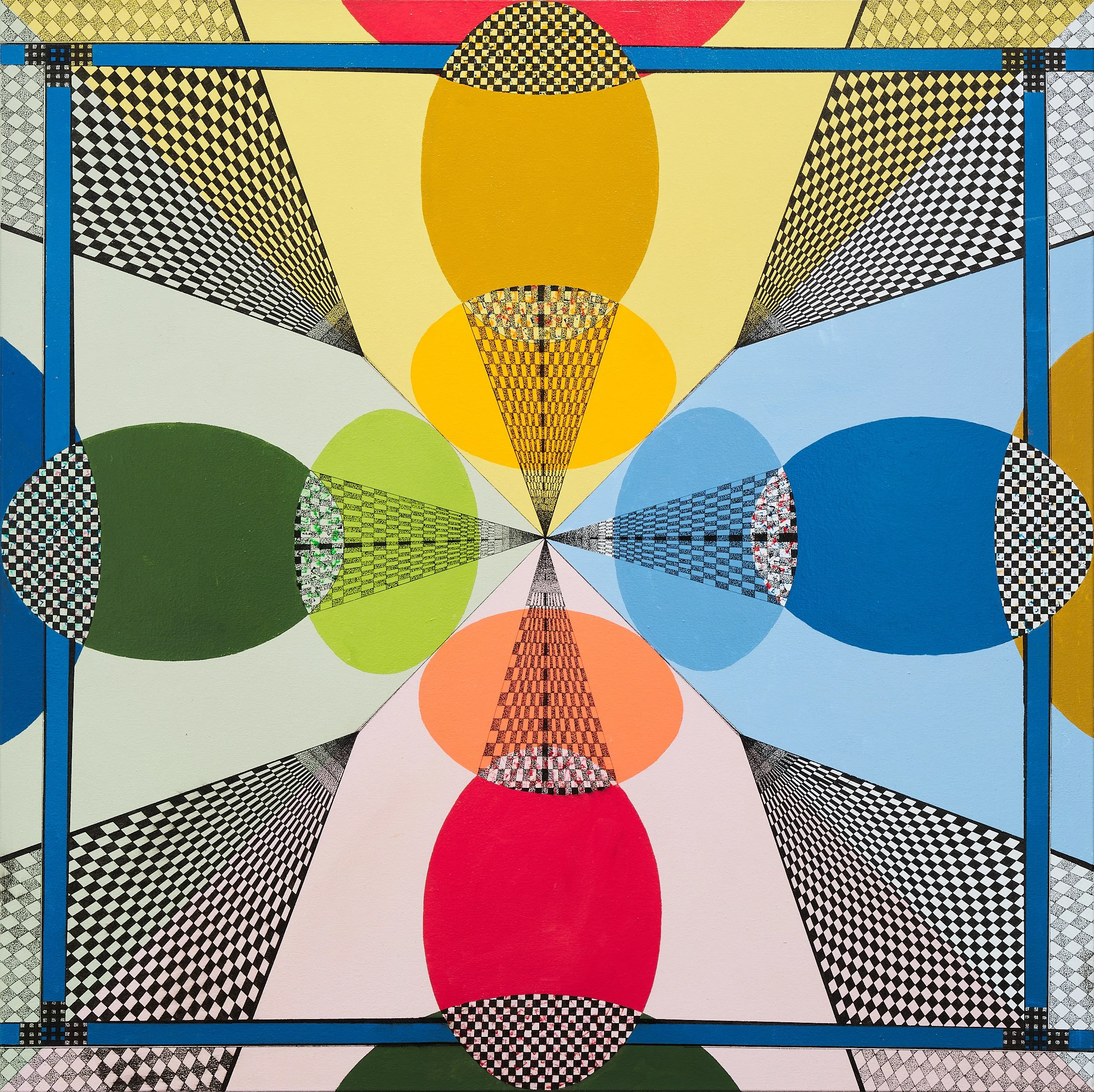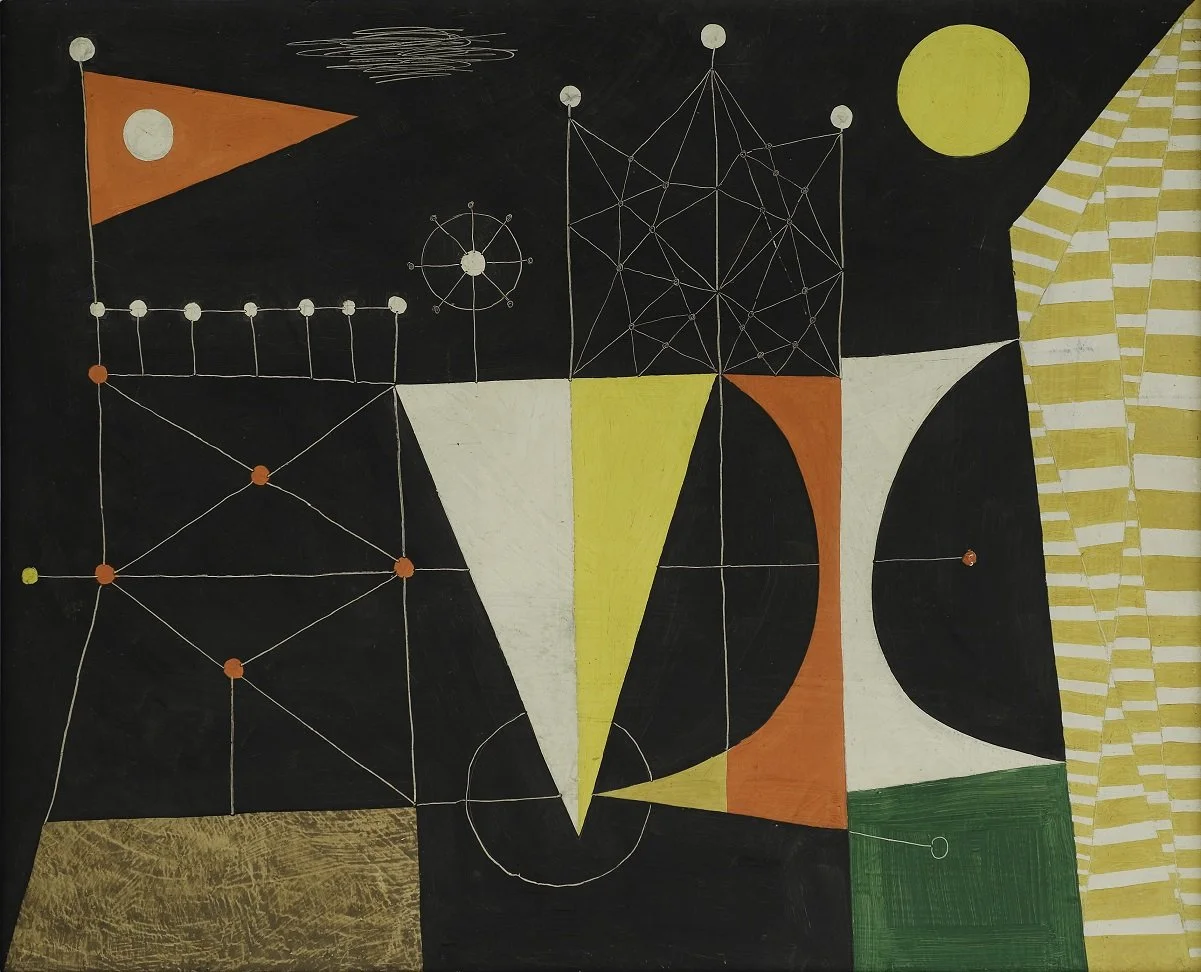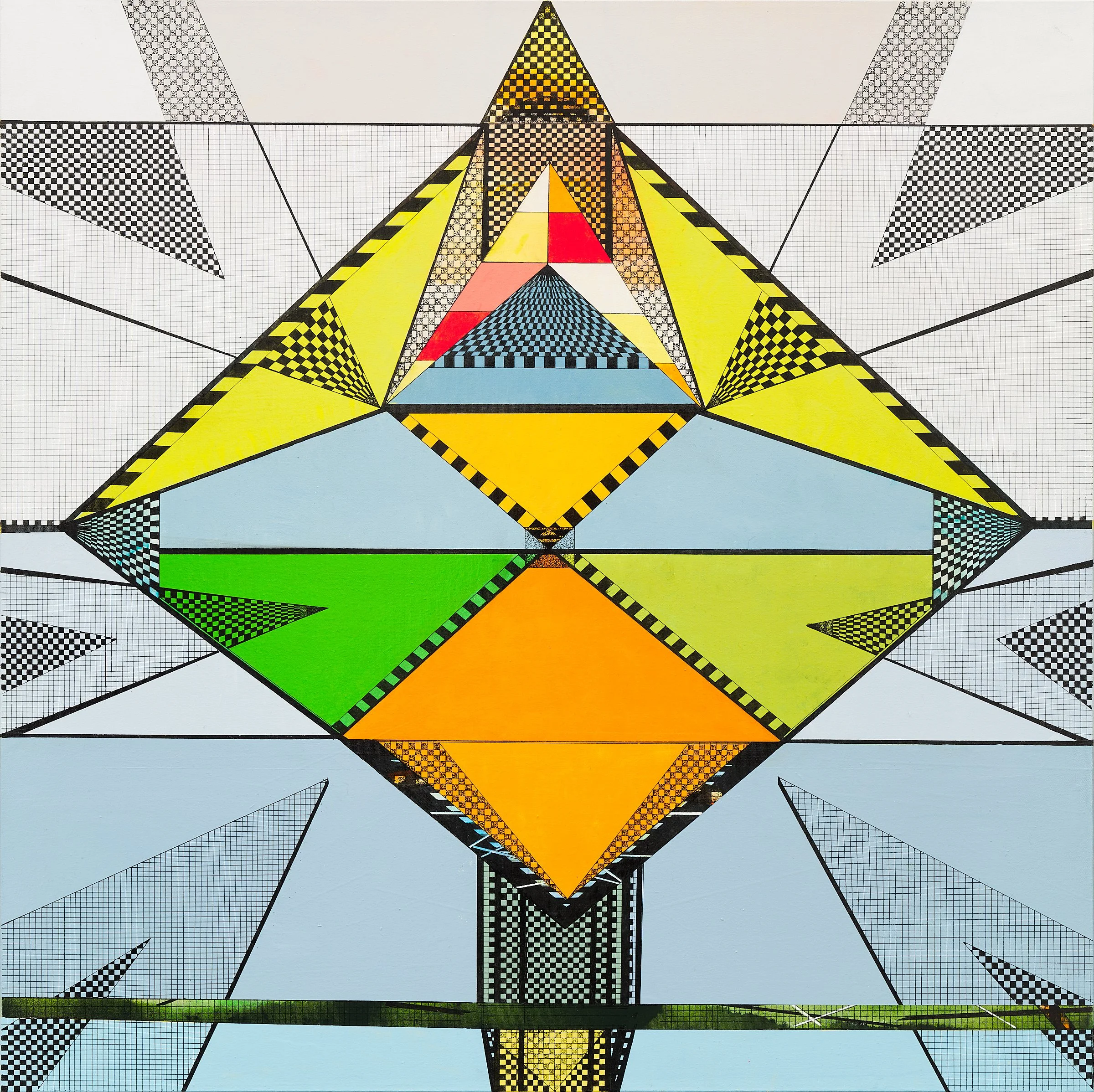West Coast Modernism celebrated in new exhibition featuring works by two local greats at West Vancouver Art Museum
Order From Chaos: B.C. Binning and Jane Adams illustrates how the work of the former inspired the latter
JaneAdams, Exactitudes, 2022, 48 x 48, acrylic paint on paper. Courtesy of the artist
West Vancouver Art Museum presents Order From Chaos: B.C. Binning and Jane Adams to September 23 as part of West Coast Modern Week
SOMETIMES, LIFELONG FRIENDSHIPS give rise to great art. Consider the connection between B.C.’s Binning and Adams families.
Bertram Charles Binning is a national icon, a key figure in the development of West Coast modernism, which merges art, architecture, and design. Having been born in Medicine Hat, Alberta, he attended the Vancouver School of Art (now Emily Carr University of Art + Design) in the late 1920s, where he studied under Charles H. Scott and Ed Varley and later taught there himself. He went on to become a professor at the University of British Columbia’s School of Architecture, eventually establishing the fine arts department. There, he instructed the likes of Ron Thom and Arthur Erickson how to draw, then collaborated with them on the artistic ornamentation of key Vancouver modern buildings. In 1941, Binning and his wife, Jessie, built the first modern residence and the only house in West Vancouver designated as a National Historic Site.
Jane Adams, meanwhile, forged a successful visual-arts career after studying at the Vancouver School of Art in the early to mid 1960s with the likes of Jack Shadbolt, Don Jarvis, Roy Kiyooka, and Orville Fisher. She worked with William Townsend at the Slade School of Art in London, England in 1965, and eight years later had her first solo exhibition at Vancouver’s Bau-Xi Gallery. She has since shown her work all across Canada and beyond. Her parents were good friends with the Binnings.
A new exhibition at West Vancouver Art Museum brings these two luminaries together. Order From Chaos: B.C. Binning and Jane Adams focuses on how the art of Binning inspired that of Adams and how certain works of each artist complement the other’s. (Order from Chaos is one of two exhibitions presented as part of West Coast Modern Week running from July 4 to 9.)
The pair’s connection goes back decades. Adams’s mother is Canadian composer Jean Coulthard (who wrote “Canadian Mosaic”); her father, Don Adams, ran a modern Scandinavian furniture store in Vancouver. They spent a lot of time with the Binnings. After B.C. Binning died in 1976, Adams remembers going to their home often to visit his wife, Jessie (who lived to be 101), with her mom. She was able to visit Binning’s studio and, in particular, she recalls seeing the legend’s large mural in the couple’s hallway. It featured small circles and triangles painted inside small squares. Adams says she realizes now that the triangles in many of her paintings of “home” are derived from this mural, and she has continued to use the triangle, mosaic, and grid patterns that appeared in Binning’s works.
“Their house was full of art; it was wonderful,” Adams says in an interview with Stir. “It was really a museum of his art. She [Jessie] promoted him for most of her life to make sure he stayed centrally focused. I was always enthralled with this work and continued to follow it. You can have influences by people, but I interpret things totally in my own way. But I love his greater body of work.”
Curated by Hilary Letwin, the exhibition includes works by Binning from the Collection of the West Vancouver Art Museum (gifted from Jessie’s estate in 2007 specifically so the art would remain in his beloved community) and pieces courtesy of Adams, whose art is held in corporate, private, and public collections, including the National Art Bank, Royal Trust, BCAA, Teleglobe Canada, and Via Rail.
Adams’s family had a house in Vancouver that had been designed by Ned Pratt of Thompson, Berwick and Pratt and Partners, the architectural firm that created the modern buildings that Binning worked on, such as the BC Electric Building. The Adams were very much embedded into the modern world that Binning was; he was known as “the grandfather of West Coast modernism”.
“She’s had this family connection growing up and growing older, and she realized a number of years ago just how influential Bert’s work was on her work,” Letwin says in an interview with Stir. “In this exhibition, we’ve brought together the work of both artists as a way to celebrate their individual developments, but also the influence of one on the other.”
B.C. Binning, Untitled (Sketch for Night Regatta),1953-55, oil paint on board, 55.5 x 45.5 cm. Courtesy ofthe West Vancouver Art Museum
Letwin curated a selection of Adams’s pieces to respond to Binning’s work from the WVAM collection.
“We selected works that exposed these conversations between these two artists,” Letwin explains. To establish the relationships, the show opens with pen and ink drawings by Binning: one a 1943 self-portrait, the other a 1953 drawing of Adams’s mother at her piano.
“From there, the show is not arranged chronologically, but we have inserted extended labels where people can explore the journeys of the two artists,” Letwin says. “We picked Jane's work based on what we had by Binning, and it was such an easy exercise to go into Jane's studio and find these works that responded so beautifully to Binning’s work. It wasn't an intentional matching up on her side; she didn’t paint her paintings based on his paintings. It’s just that there was this incredibly natural relationship between the two. I love these visual moments that come together.”
Consider a work by Binning called Landscape with Sun (Sketch) from 1961 and Adams’s Time Framed (A kite flying in the wind at Kits Point, 2023). “You can see these great colour fields of yellow and red and white that are the same colour palette, and so we start to get to know both of them as artists,” Letwin says.
Two of Binning works are borrowed from the Belkin Gallery at UBC. Fair Weather Signals from 1954 is oil painted on burlap, an intriguing material he used fairly often. Paired with it is Adams’s Pendulum (Balancing work and play at home) from 2020. “Again, it’s a marvelous example of how Jane wasn’t working from Binning’s work, but there are these great formal relationships between the two artists. The yellow triangles, for example, that respond exactly to Binning’s shapes.”
Other examples, such as Adams’s Interior Mural 1 and II (A painting inspired from the mural in the hallway of the Binning House) of 2023 illustrate how she references Binning’s works that adorned his home and that she got to see up close in place.
A screen print by BC Binning from quite late in his career, called Merging Sides, is displayed next to Adams’s Laneway Summer. Visitors will see how the formal composition and the red and green circles in each complement one another.
The exhibition gives a nod to Binning’s love of marine vessels and the coast itself; he and his wife were avid sailors. “He would write and talk about his relationship to being on a boat and exploring the natural Northwest landscape through this lens of sailing,” Letwin says. “And he was also well known to cycle up and down Marine Drive and on his bicycle with his sketchbook and stuff under his arm and catching different viewpoints of the West Vancouver shoreline.”
Jane Adams, Time Framed, 2023, acrylic paint on paper, 36 x 36 inches. Courtesy of the artist
Pen and ink drawings by Binning, which have graphic relationships with some of Adams’s works, also appear in the show. Adams’s Coal Harbor Series (Ferry boast crossing Coal Harbour), from 2020, features dots, squares, rectangles, parallel lines, and the outline of a ship, tying into the maritime theme. It’s paired with Binning’s Four Ships on Northwesterly Course, borrowed from the Belkin. “He also found nautical symbols and abstracted shapes of boats to be a really compelling subject matter,” Letwin says, pointing to a study for a larger maritime-themed painting, Untitled (Sketch for Night Regatta) as another example. “So we have a number of paintings by him that dance around the sea and we have a further number of Jane’s works in conversation with works by Binning.”
The third and final gallery may be Letwin’s favourite. There is a mosaic of Binning’s made of Venetian glass tesserae, which he sourced straight from Italy. It was a style he embraced in the 1950s and 1960s, in large-scale format, with many examples around the city, including at the BC Electric Building. This particular mural, which is now part of the WVAM collection, came from the CKWX radio station that was being demolished, a gift to the museum upon being salvaged. This blue-on-blue artwork is displayed next to Adams’s Exactitudes (Centrifugal moments), 2022, which incorporates some of the same colour palette. Adams says she was influenced by this mural and that in her mind, it has always been a metaphor for Canada.
Then there’s a small Lego panel by Lego master Paul Hetherington, who grew up in West Vancouver and who now has a show running concurrently called The Bricktacular West Coast Modern Show at the West Vancouver Memorial Library (on until July 31).
Adams hopes that the exhibition will leave people with a sense of colour, joyousness, and lives lived.
For Letwin, the show points to the fact that artists don’t exist in vacuums. “Artistic influence, while it can be amorphous, is not always a linear line from one artist to the next,” she says. “There are larger networks, connections, and relationships that have an impact on subsequent generations of artists. Binning is one of the more influential of local modern artists within the Vancouver scene, and this is a really excellent way to illustrate that by showing Jane’s work in tandem.”















